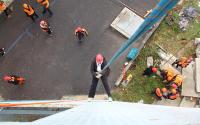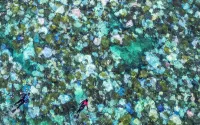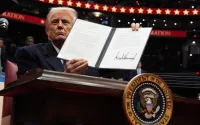The CounterPunch / The Independent , September 24, 2001
Our aging Russian-built helicopter flew into the Panjshir valley from the north, high over desolate, brown hills. At Changaram, a narrow point in the valley where lush, green fields and terraces cling to the sides of the mountains, we landed.
All along the narrow dirt road are signs of the fate of armies which have tried to fight their way into the Panjshir over the past quarter century.
I stopped counting the carcasses of burnt-out and long-abandoned Soviet tanks after a few miles. In some places, old tank treads had been used to fill potholes in the road. The top of another tank could be seen just below the surface of the river.
The Panjshir valley--perhaps the greatest natural fortress in the world--is one of the last strongholds of the Afghan opposition. It points like a bright green arrow at Kabul, which is controlled, like the other nine-tenths of the country, by the Taliban militia.
Abdullah Abdullah, the foreign minister of the Northern Alliance, the main opposition grouping, was in a cheerful mood as he sat, surrounded by flowers, in the garden of his headquarters at Jabal Saraj, a dusty town 20 miles inside Afghanistan. For some reason, a small canary had been placed near a bush beside him.
Dr Abdullah, a suave engaging man, has for years tried, with limited success until two weeks ago, to interest the rest of the world in his views. The Afghan opposition felt itself to be alone, even abandoned. Suddenly everything it has said about the Taliban is being repeated by world leaders, from Washington to Tokyo.
The world may be waiting for the war to start but here the war--in one form or another--has been going on for 20 years. And that war, in anticipation of the wider war, is already heating up.
Mr Abdullah's forces had launched an offensive far to the west, he said. They were trying to recapture Mazar-i-Sharif, a city held by the Taliban since they captured it and conducted a particularly savage massacre against the Shia Muslim minority in 1997.
I asked if he knew the whereabouts of Osama bin Laden. "I wish I did," he said, adding that he had information that Mr bin Laden "had gone into hiding several days ago near Kandahar in the province from where the family of Mullah Omar, [the one-eyed leader of the Taliban] originally came from". Asked if he had informants among those around Mr bin Laden, he said that he relied rather on radio intercepts.
He has one serious worry, however. It was extraordinary, he said, that the United States appeared to be relying on Pakistan and above all on Pakistan's intelligence service to go after the Taliban. This "is the same deadly organisation which created the Taliban," Mr Abdullah said. "It is now meant to be acting against them. But I assure you that Pakistani intelligence has people in it who are as fanatical as bin Laden or Mullah Omar". Among the Afghan opposition, hatred of Pakistan for creating the Taliban is almost visceral.
Nevertheless Mr Abdullah is probably right in thinking that the Taliban are doomed. The opposition, mostly drawn from Afghanistan's minorities, are beginning to emerge from their strongholds.
The first sign of this is the attack over the last three days on Mazar-i-Sharif by the Uzbek General, Abdul Rashid Dostam, from his base south of the city in the mountain gorges that even the Soviet army was never able to conquer.
Despite the might of the forces now mustering against them, most of the Taliban's frontline fighters--even local leaders--probably do not know exactly what is happening. The Northern Alliance says Arabs and Pakistanis fighting in the Taliban's ranks began to leave about a week ago.
None the less, Mr Abdullah believes that about 60 per cent of the Taliban's 60,000-strong army will not desert. "They believe that Mullah Omar has direct contact with God," he says. "They will die for him and they will kill for him." The three cities where the Taliban are concentrating their forces are Kabul, Kandahar and Jalalabad. They are also moving ammunition dumps, splitting up units so they are less vulnerable from the air and fortifying positions.
We took off early in the morning from Khodjabahutdin, a village of mud-brick houses, in northern Afghanistan close to Tajikstan where our helicopter had been forced to put down overnight because of bad weather and fading light. Officials examined our papers closely because it was here, on 9 September, that two men carrying Belgian passports but believed to be Arab, posed as television journalists to assassinate Ahmed Shah Masood, the opposition military leader, in a suicide bomb attack.
The death of Masood, so closely followed by the devastating air attacks on the World Trade Centre and the Pentagon, has suddenly focused intense international attention on the endless war in northern Afghanistan. In the Panjshir, a poster with Masood's picture and a red rose, from which four drops of blood fall, is everywhere.
The Afghan opposition forces in the north are not large. They have about 15,000 well-trained men, many of them in the Panjshir, and another 40,000 militia, but they are now--finally--likely to receive as much money and as many arms as they want.
Not that there is much of a shortage of weaponry in the Panjshir valley. A large number of old Soviet tanks sit in jerry-built military compounds beside the road. I saw a family being driven around in an old Soviet-like tank from which the gun had been removed. Apparently it was being used as a taxi.






